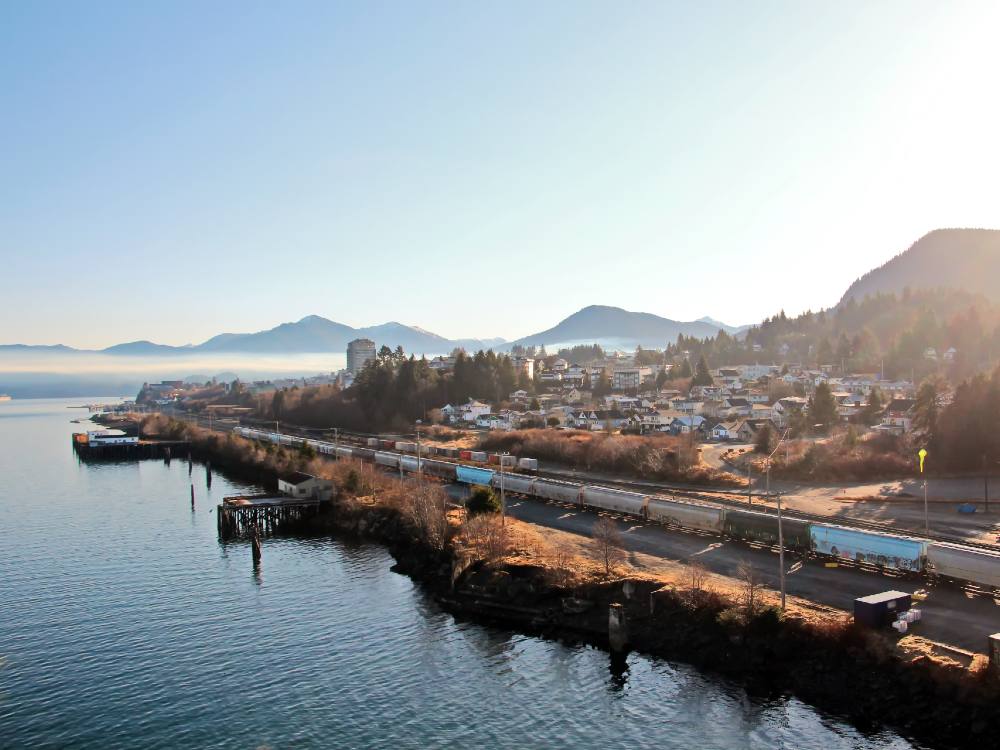An inland gas liquefaction facility proposed for north of Prince George could make Canada the first country in North America to make liquified natural gas a regular commodity on its rail lines and is raising concerns about safety.
Summit Lake PG LNG entered B.C.’s environmental assessment process in January and is about to wrap up a month-long public consultation period. If approved, it could begin construction in early 2026, the company says, with plans to become operational in 2028.
The handful of LNG processing plants already approved in B.C. — including LNG Canada, which is nearing completion in Kitimat — are all planned for the coast. They would process gas shipped from Alberta and northeast B.C. by pipelines and load the liquefied fuel directly onto tankers destined for overseas markets.
But the Summit Lake project, proposed by JX LNG Canada, a Calgary-based subsidiary of Chinese compressed gas company Changchun Jixing New Energy Ltd., is unique. It would require just a two-kilometre pipeline to connect to Enbridge’s gas transmission network. Its proposed facility is 30 kilometres north of Prince George, roughly 500 kilometres from the coast. The plant would then liquefy the product and load the LNG onto trains for shipment to the port in Prince Rupert.
The prospect of shipping liquefied gas by rail — a method that’s only seen limited use in places like the U.S., Japan and Europe — has environmentalists concerned about increasing hazardous materials on railways through the region.
“Nobody’s had a Lac-Mégantic scenario yet with these ISO containers full of LNG, and so there's really no real-world data on how they behave when they rupture,” said Kai Nagata, communications director with Dogwood BC.
Nagata estimates that the project would add thousands of railcars every month to northern B.C.’s already congested tracks. It’s a concern, given the potential for train disasters, he said.
He points to a recent diesel locomotive fire that was reported April 21 near Quick, B.C., 350 kilometres west of Prince George.
A local volunteer fire department was called in to extinguish the blaze, CN Rail confirmed in an email to The Tyee, which “resulted in fires along the CN right of way, all of which were extinguished by local emergency services.” The company didn’t respond to questions about how many fires were ignited and over what distance.
Little is known about how LNG might react after a spill, Nagata said.
“In an open-air environment, supposedly it just rolls out across the landscape, freezing everything, and then it re-gasifies and if there's no source of ignition, then it just evaporates into the air,” he said. But if the fuel were to ignite, he added, “that seems like a real concern.”
The U.S. government has grappled with the issue of shipping LNG by rail. Last August, it suspended a 2020 decision by the Trump administration that allowed railways to ship liquefied gas, saying more investigation was needed around safety concerns. A decision on whether to proceed with shipments is expected by June 30.
Why put the Summit Lake project inland?
The process of turning gas to a liquid is energy intensive, involving cooling the gas to below -160 C. B.C. is currently planning a $3-billion electric transmission line to bring power to LNG plants on the coast.
One motivation for placing the Summit Lake project near Prince George is easy access to the power grid, Nagata said.
According to documents filed with B.C.’s Environmental Assessment Office, JX LNG Canada says a new six-kilometre power line would provide electricity to the Summit Lake facility but its draw “will not be sufficient to negatively impact communities.”
Planned for two stages, the completed project would produce up to 2.7 million tonnes of LNG each year, roughly one-fifth of LNG Canada’s capacity. It would be located on a 250-hectare plot that would include storage capacity for up to 200,000 cubic metres of LNG.
The project is expected to employ up to 500 people during peak construction, with construction workers housed at camps near the project site. Ongoing operational staffing is projected at close to 100 people once the second phase of the project is completed, the company said in EAO documents.
Local resident Hilary Crowley said those workers are unlikely to come from the tiny community of Summit Lake, located 11 kilometres north of the project site, where residents are primarily retirees, cabin owners and commuters working in Prince George.
“Nobody living in Summit Lake will be looking for work on that plant,” Crowley said. “We’re not very happy about it.”
Crowley said some local residents attended a recent information session about the project in Prince George. Many expressed concerns about wildlife, water quality, noise and an increase of dangerous goods on the railway. She said the project location, which is within a few kilometres of both the Salmon and Fraser rivers, is frequented by elk and popular with berry pickers.
According to the company’s engagement plan, which was filed with the EAO in January, Lheidli T’enneh First Nation, on whose traditional territory the project is proposed, offered “positive initial feedback” and a preliminary letter of support.
In an email to The Tyee, Chief Dolleen Logan confirmed the nation’s support for the project and said she hopes the project would bring employment opportunities for members and others in the region, particularly with the recent downturn in the forest industry.
She also echoed the concerns of other First Nations in the area, summarized in the company’s EAO documents, around water quality and wildlife, and said the nation intends to work closely with the company as the project moves forward.
“We have forestry, natural resources and fisheries departments that all work together on our environmental concerns within our territory,” Logan said, adding that water is a “major concern” as the region battles a major drought.
“Lheidli T’enneh will be working closely with the company every step of the way. We think this project will be great for not only our community but Prince George and surrounding area.”
JX LNG Canada said it takes the community’s concerns seriously.
“Our priority is always the safety of the community and the environment,” Sam Chui, a project manager with Keywest, wrote on behalf of the company. “As the project progress, specific concerns will be addressed and mitigated through further stages of the [environmental assessment] process. Plans will be implemented to minimize noise pollution, protect watersheds, and ensure the safe transportation of hydrocarbons.”
JX LNG Canada’s website states that the project will have “no direct impacts on water or aquatic life” and produce net-zero greenhouse gas emissions by connecting to the BC Hydro power grid.
“LNG produces significantly less [greenhouse gas] emissions and other pollutants than other fossil fuel options. The construction of the project will enable the export of LNG to meet growing demand across the globe,” the company said in its EAO submission.
LNG has been touted as a greener fossil fuel that could allow power plants in China to transition from coal, reducing overall global emissions.
But skeptics point out that China is rapidly transitioning to renewable energy without LNG as a “bridge fuel” and that comparisons between LNG and other fossil fuels don’t account for impacts specific to LNG, such as hydraulic fracturing, or fracking, to extract gas and methane leakage, during shipping.
JX LNG Canada told The Tyee that there are currently no formal agreements for the use of its LNG overseas, but that its parent company in China “does supply LNG to power plants already.”
As B.C. works to reduce its greenhouse gas emissions, Nagata questioned the logic of dedicating renewable energy from B.C.’s power grid to the expansion of the fossil fuel industry.
The opportunity to comment on the Summit Lake PG LNG project closes Thursday. ![]()
Read more: Energy, Transportation, Environment

















Tyee Commenting Guidelines
Comments that violate guidelines risk being deleted, and violations may result in a temporary or permanent user ban. Maintain the spirit of good conversation to stay in the discussion and be patient with moderators. Comments are reviewed regularly but not in real time.
Do:
Do not: